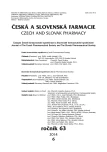Influence of excipients on caffeine permeation from gels
Authors:
Alexandra Kodadová; Zuzana Vitková; Petra Herdová; Jozef Čižmárik; Monika Zsidová
Authors‘ workplace:
Farmaceutická fakulta UK Bratislava
; Katedra galenickej farmácie
Published in:
Čes. slov. Farm., 2014; 63, 267-271
Category:
Original Articles
Overview
The subject of this paper is a study of the influence of excipients on caffeine permeation from dermal semisolids drugs. Due to its advantageous properties, caffeine can be successfully used in dermal hydrogels. The choice of excipients from the group of humectants and cationic surfactants also plays an important role. The excipients should ensure long-term stability of hydrogels and the best permeation of the drug from gels. In particular, the influence of various excipients on caffeine permeation from gels and at the same time their influence on rheological properties of hydrogels were investigated. Based on the obtained results, the following optimal composition of caffeine gel was determined: 2.5 % chitosan + 0.1 % caffeine + 10 % propylenglycol + 0.1 % benzyldimethylhexadecylammonium chloride.
Keywords:
caffeine • hydrogels • permeation • rheological parameters
Sources
1. Herman A., Herman A. P. Caffeine’s mechanism of action and its cosmetics use. Skin. Pharmacol. Physiol. 2013; 26, 8–14.
2. León-Carmona J. R., Galano A. Is caffeine a good scavenger of oxygenated free radicals? J. Phys. Chem. B, 2011; 115, 4538–4546.
3. Otberg N., Patzelt A., Rasulev U., Hagemeister T., Linscheid M., Sinkgraven R., Sterry W., Lademann J. The role of hair follicles in the percutaneous absorption of caffeine. Br. J. Clin. Pharmacol. 2007; 65, 488–492.
4. Bansal M., Machanda K., Pandey S. S. Role of caffeine in the management of androgenetic alopecia. Int. J. Trichology, 2012; 4, 185–186.
5. Mohamed N. A., Fahmy M. M. Synthesis and antimicrobial activity of some novel cross-linked chitosan hydrogels. Int. J. Mol. Sci. 2012; 13, 11194–209.
6. Basu K. S, Kavitha K., Rupeshkumar M. Evaluation of ionotropic cross-linked chitosan/gelatin b microspheres of tramadol hydrochloride. AAPS Pharm. Sci. Tech. 2011; 12, 28–34.
7. Yajun X., Xiaofei L., Qiang, CH. Synthesis and characterization of water soluble chitosan derivate and its antibacterial activity. Carbohydr. Polym. 2007; 69, 142–142.
8. Uragami T., Tokura S. Material science of chitin and chitosan. 1. vyd. Japan: Kodansha Scientific Ltd. 2010; 284–284.
9. Vavříková E., Vinšová J. Chitosan a jeho farmaceutická aplikace. Chem. Listy 2009; 103, 56–57.
10. Herdová P., Vitková, Z. Štúdium liberácie liečiv z chitosanových hydrogélov. Derma 2010; 10, 2–20.
11. Kodadová A., Vitková Z., Herdová P. Hodnotenie liberácie kofeínu z dermálnych polotuhých liekov. Čes. slov. Farm. 2013; 62, 220–222.
12. Vitková Z., Oremusová J., Herdová P., Kodadová A. Release and Rheological Properties of Topical Drugs. Tenside Surfact. Det. 2013; 50, 39–44.
13. Senel S., Ikinci G., Kaş S., Yousefi-Rad A., Sargon M.F., Hincal A.A. Chitosan films and hydrogels of chlorhexidine gluconate for oral mucosal delivery. Int. J. Pharm. 2000; 193, 197–203.
14. Herdová P., Kodadová A., Vitková Z. Vplyv enhanceru na tokové vlastnosti hydrogélov. In : Zborník Preveda – IV. interaktívna konferencia mladých vedcov. Bratislava 2012; 70.
15. Čižmárik J., Vitková Z., Herdová P., Kodadová A., Vími D. Fomulácia benzetóniumchloridu do gélov. Čes. slov. Farm. 2014; 63, 123–126.
16. Vitková Z., Herdová P., Kodadová A., Šeligová J., Grančai D., Poláková D. Formulácia gélov s obsahom šalvie lekárskej. Čes. slov. Farm. 2012; 61, 169–171.
17. Capková Z., Vitková Z., Uhrovská S. Vplyv humektantov na farmaceutickú dostupnosť a reologické vlastnosti hydrogélov s cetirizínom. Čes. slov. Farm., 2005; 54, 226–230.
18. Kodadová A., Vitková Z., Herdová P., Šeligová J. Vplyv teploty a tenzidu na reologické vlastnosti chitosanových hydrogélov. In: Zborník Preveda – V. interaktívna konferencia mladých vedcov. Bratislava 2013; 53.
19. Kodadová A., Vitková Z., Herdová P., Oremusová J., Fořtová M. Vplyv teploty na liberáciu kofeínu z hydrogélov s obsahom kvartérnej amóniovej soli. In: Zborník abstraktov zo VI. vedeckej konferencie „Mladí vedci – bezpečnosť potravinového reťazca“. Bratislava 2013.
20. Kopecký F., Kopecká B. Fyzikální a fyzikálně-chemická teorie léků jejich forem. In Technologie léků. 3. vydání. Praha: Galén 2006; kap. 2, 14–15.
Labels
Pharmacy Clinical pharmacologyArticle was published in
Czech and Slovak Pharmacy

2014 Issue 6
Most read in this issue
- Examples of off-label use of human medicinal preparations in veterinary medicine
- An overview of urease and its relation to the ureolytic bacteria and the search for new urease inhibitors
- Nanoparticulates with drug release based on temperature change
- Clinical trials in the European Union and the Czech Republic in the years 2006, 2009 and 2012
